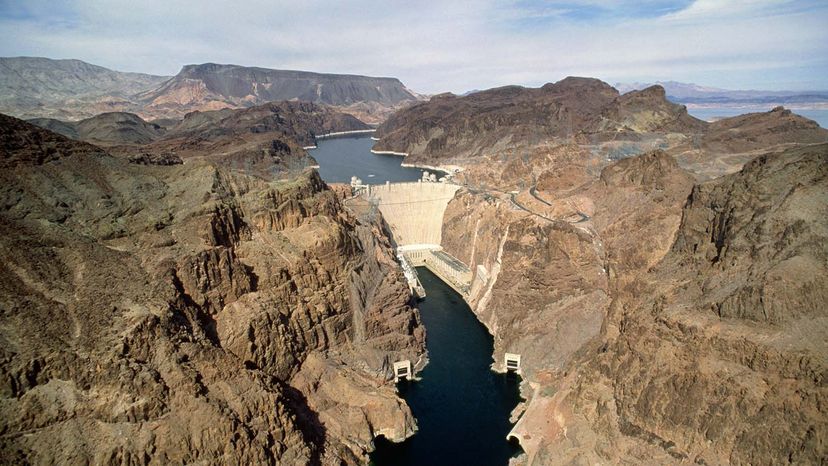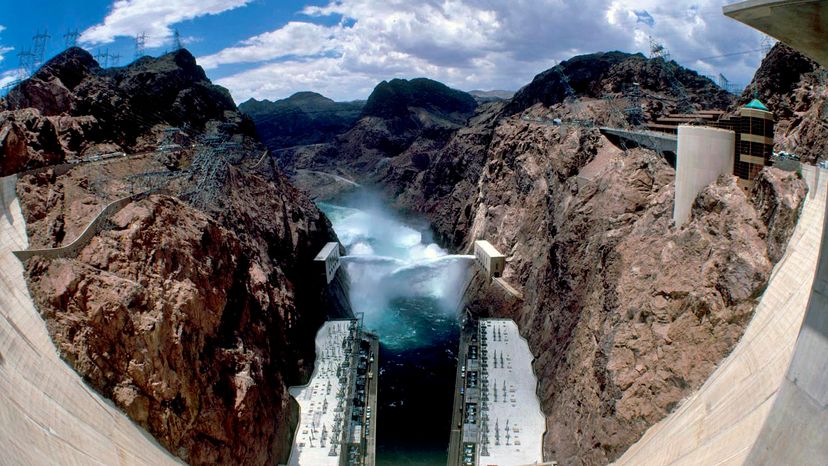By: Patty Rasmussen|Updated: Aug 14, 2023

It might be the most impressive U.S. public works projects ever. We're talking about the Hoover Dam, the largest man-made reservoir and a feat of American engineering. It holds back 45,000 pounds per square foot of maximum water pressure at the base of the dam. But have you ever wondered what would happen if the Hoover Dam broke?
It's located on the wild Colorado River on the border between Arizona and Nevada. In terms of sheer size, it's massive — standing 726.4 feet (221.4 meters) from foundation to the roadway at the top. That makes it more than 171 feet (52 meters) taller than the Washington Monument.
Advertisem*nt
Shaped like a crescent wedge, the top of the dam is just 45 feet (13 meters) thick, but its base is 660 feet (221 meters) thick — the same distance as the length of two football fields measured end to end. And it's made of sturdy stuff. There is enough concrete in the Hoover Dam (4.5 million cubic yards) to build a two-lane road from Seattle to Miami.
If you've wondered what would happen if the Hoover Dam broke, you're not the only one. Granted, it's difficult to imagine what could cause such a break — a massive explosion of some type, a natural disaster of epic proportions or an equally epic human error. But the first thing that would happen is that the reservoir created by the dam, Lake Mead, would be breached.
At full pool, Lake Mead is, by volume, the largest reservoir in the United States. It has enough capacity to hold the entire average annual flow of the Colorado River for two years. As recently as 2016, Lake Mead held up to 9 trillion gallons (34 trillion liters) of water. But with drought conditions in the West, the lake currently holds about 3.5 trillion gallons (13.2 trillion liters) of water. Now, if 3.5 trillion gallons of water were suddenly set loose, it would certainly wreak havoc on everything in its path.
Advertisem*nt
Contents
- Damage to the Dam
- More Fallout from Hoover Dam Failure
Damage to the Dam

If disaster struck and the Hoover Dam stopped functioning, a catastrophic amount of water from Lake Mead would be released. That water would likely cover an area of 10 million acres (4 million hectares) 1 foot (30 centimeters) deep. To put that area in perspective, the entire state of New Jersey is 9 million acres (3.6 million hectares).
Downriver towns and major cities would see the most damage, in the event of the dam's physical collapse. Water flows would engulf many towns and growing cities around Mohave county, including Laughlin, Nevada; Needles, California; Lake Havasu, Arizona; and even as far south as Yuma, Arizona, and San Luis Rey, Colorado. Without any advanced warning about the physical breach, Lake Mead's water levels could result in significant losses of life.
Advertisem*nt
There are also three Native American reservations along the Colorado River that would be affected if the dam's walls collapsed. Some speculate the water would spread into the Mojave National Preserve and communities in southeastern California all the way to the Salton Sea, an area that was routinely flooded by the Colorado River before the dam was built in the 1930s.
More Fallout from Hoover Dam Failure
Approximately 25 million people depend on water from Lake Mead. The reservoir supplies water for the cities of Las Vegas, Henderson, North Las Vegas and Boulder City, Nevada, as well as municipal and industrial water and irrigation water for users on the downstream side.
The destruction of irrigation water supplies would also have a devastating effect on farming in the region. Farmers in the Imperial Valley get most of their water from the Colorado River basin, and these irrigation systems would collapse. Prior to irrigation, the Imperial Valley was a barren desert. Today it is home to more than half a million acres of farmland and produces more than a billion dollars in fruits and vegetables every year.
Advertisem*nt
And then there's the electrical grid. Hydropower generation was a major reason for building the Hoover Dam. In fact, it not only financed the project, but income from hydroelectric power generation also continues to pay for the operation, maintenance and replacement work at the dam. According to the U.S. Bureau of Reclamation, Hoover Dam produces on average about 4 billion kilowatt-hours of hydroelectric power, annually, for use in Nevada, Arizona and California. That's enough to cover the electricity needs of 1.3 million people.
Frequently Answered Questions
What will happen to Vegas if Lake Mead dries up?
If Lake Mead were to dry up, Las Vegas would be majorly affected. The city gets approximately 90% of its water from the lake. Without enough water, the city would quickly become uninhabitable.
Lots More Information
Related Articles
- How Hydropower Plants Work
- 10 Innovations in Hydropower
- How Evaporation from Lakes and Reservoirs Could Sustainably Power a Nation
- How Electricity Works
More Great Links
Cite This!
Please copy/paste the following text to properly cite this HowStuffWorks.com article:
Citation
More Awesome Stuff
Advertisem*nt
Advertisem*nt
Loading...
\n\n\t\t\t\t
`;t.byline_authors_html&&(e+=`By: ${t.byline_authors_html}`),t.byline_authors_html&&t.byline_date_html&&(e+="|"),t.byline_date_html&&(e+=t.byline_date_html);var i=t.body_html.replaceAll('"pt','"pt'+t.id+"_");return e+=`\n\t\t\t\t
\n\t\t\t\t
\n\n\t\t\t\t
${i=i.replaceAll("#pt","#pt"+t.id+"_")}
\n\n\t\t\t
`}(a);this.loadedDiv.innerHTML+=n,document.title=a.title+" | HowStuffWorks";let s="content-loaded-"+a.id,l=document.getElementById(s);l.dataset.contentId=a.id;let o=l.querySelectorAll(".lazyload");HSW.utilities.lazyLoadElements(o),HSW.ux.editorial.init({twitter:!0,facebook:!0,instagram:!0}),l.querySelectorAll(".toc a").forEach(t=>{t.addEventListener("click",t=>{t.preventDefault();let e=t.target.dataset.target,i=document.querySelector("a[name='"+e+"']");i?i.scrollIntoView({behavior:"auto"}):console.error("Unable to locate target with name "+e)})});try{if(userData.adsActive)if(HSW.utilities.isMobile()){l.querySelectorAll(".ad-mobinline").forEach(t=>{t.setAttribute("id","ad-wrap-mobinline"+r),t.childNodes[0].setAttribute("id","ad-div-mobinline"+r),void 0!==HSW.ads&&HSW.pq.add(()=>{HSW.ads.addNewUnits(["ad-div-mobinline"+r])},"ads"),r++})}else{let t=document.createElement("div");t.setAttribute("id","ad-after-"+e),t.classList.add("ad-inline","mb-8","bg-gray","w-max-full","h-min-90","text-center");let a=document.createElement("div");a.setAttribute("id","ad-div-inline"+i),t.appendChild(a),l.after(t),void 0!==HSW.ads&&HSW.pq.add(()=>{HSW.ads.addNewUnits(["ad-div-inline"+i])},"ads")}}catch(t){console.error(t)}if(window.setupSinglePageUX(l),history.pushState)try{history.pushState(null,a.title+" | HowStuffWorks",a.href)}catch(t){console.warn(t)}var c=[];a.taxonomy.forEach((t,e)=>{c[e]=t.title.toLowerCase()});var d=c.join("/"),h=[];a.authors.forEach((t,e)=>{h[e]=t.first_name.toLowerCase()+" "+t.last_name.toLowerCase()});var g=h.join(",");pageMetricsData.href=a.href,pageMetricsData.title=a.title,pageMetricsData.tax=d,pageMetricsData.aType=a.asset_type,pageMetricsData.cType=a.type+"-continuous",pageMetricsData.template=a.template,pageMetricsData.source=a.source,pageMetricsData.sponsor=a.sponsor,pageMetricsData.author=g,pageMetricsData.contentid=a.id,pageMetricsData.image=a.hero_image,pageMetricsData.page=0,pageMetricsData.pubDate=a.publish_date.slice(0,10),pageMetricsData.editDate=a.last_editorial_date.slice(0,10);const u=/[^\da-z_]/i;let p=HSW.utilities.isMobile()?"hsw_lite":"hsw";a.taxonomy.slice(1,3).forEach((t,e)=>{p+="|"+t.title.replace(u,"").toLowerCase()}),pageMetricsData.adUnit=p,Alpine.store("share",{title:pageMetricsData.title,url:pageMetricsData.href,image:pageMetricsData.image}),function(t,e){let i=t.href.split(".com/").pop();dataLayer.push({event:"virtual-page-view",virtualPageUrl:i,virtualPageTitle:document.title,pageNbr:0}),dataLayer.push({event:"raw-event-interactive",eventCategory:"page-interaction",eventAction:"continuous-load",eventLabel:"new-content",eventValue:e+1,virtualPageUrl:t.href})}(a,this.items.length);const m={...pageMetricsData};t.items.push(m);for(var f=document.getElementsByClassName("new-content-loaded"),v=0;v